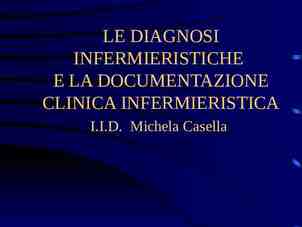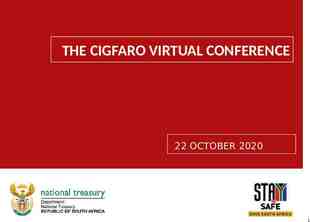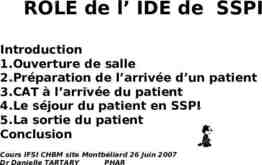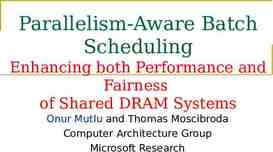Goal Setting In Occupatio nal Therapy Sarena Jones Allied
32 Slides1.89 MB

Goal Setting In Occupatio nal Therapy Sarena Jones Allied Health Support Services [email protected]

Objectives Understand what a goal actually is Understand what goal setting in OT means Understand the importance of goal setting for both the therapist and the client Understand goal setting models & outcome measures - SMART - COPM - PSFS - GAS Explore and practice goal setting within the NDIS framework

‘The object to which effort or ambition is directed; the destination of a journey’ (Oxford English Dictionary) TWO components of a ‘goal’ What is Goal Setting? 1.The end state 2.The effort to get there A goal is therefore a ‘future state’ and in the context of rehabilitation, will usually mean a CHANGE from the current state (or a maintenance of current state if the client is expected to deteriorate) A goal refers to the INTENDED outcome as a result of actions undertaken by the client, supports and/or health professionals involved

For our clients Why Do We NEED To DO Goal Setting? Goal setting is considered to improve client engagement in therapy and make rehabilitation more meaningful to individuals. Far better client outcomes For us as Clinicians It informs your clinical reasoning Gives you a clear plan for meaningful intervention that is more likely to achieve higher outcomes If done correctly, you have measures of your success! The inability of patients to participate fully in the goalsetting process largely determines the approach taken by therapists (Leach et al 2009)

SMART Goals SMART goals are a relatively new idea. In 1981, George T. Doran, a consultant and former director of corporate planning for Washington Water Power Company, published a paper, “There’s a SMART Way to Write Management’s Goals and Objectives.” In the document, he introduces SMART goals as a tool to create criteria to help improve the chances of succeeding in accomplishing a goal. (Eby, 2009) What does S.M.A.R.T goals mean to you?

SMART goals S Specific – (smart, strategic, significant, simple ) M Measurable – ( meaningful, motivational, manageable ) A Achievable – (attainable, assessable, acceptable, actionable.) R Relevant – (realistic, reasonable, rewarding, recorded, robust ) T Time-Limited – ( trackable, tangible, timely ) E Evaluate, exciting, ethical, engaging R Re-Do, recorded, reviewed, rewardable (Wade 2009)

S Specific - The who/what/when/where/how questions SMART goals – HOW TO! M Measurable - What metrics are you using to determine success? - Formalised outcome measure? A Achievable - Does it required learning new skills? New attitudes or understanding? - Does it require medical improvements? R Relevant - Is it highly valuable for the client or carer? - Why are we setting this goal now? T Time-Limited - What’s the deadline? Is it realistic timing? - Short term Vs longer term goals or sub-goals

SMART Goal E.g’s The client will Exercise for 30 minutes at least four days per week for two months. Achieve 8 hours minimum of sleep every night for 10 days, trackable via her watch. Attend Church each Sunday for 8 out of the next 10 weeks. Walk at least 10,000 steps tracked on a pedometer at least five days per week. Confidently and independently manage my own anxiety during grocery shopping by using my strategies, 3 times this month in order to complete my weekly grocery shopping in one trip. Quick THINK – personal goal example – then try to change it into SMART format Share with the

SMART Goal - TIPS As you’re listening to their story, ask ‘is that something I could help you to achieve? Is that something you would like to be able to do again?’ Why is that important to you? When was the last time you were doing that activity? Eg walking 30mins, or playing piano, or sleeping 8 hrs a night Combination of short-term (success is good!) and more difficult or longer term goals What’s annoying you the most? If you had a magic wand what would you change if you could?

Goal Attainment Scale The GAS was first introduced in 1968 and was intended for use in the evaluation of mental health services (Kiresuk & Sherman, 1968) GAS is an individualized outcome measure involving goal selection and goal scaling that is standardized in order to calculate the extent in which the client’s goals are met. Free and easy to use, however may be time consuming initially Used in DVA funding models Highly valued in the literature as an outcome measure Recommended for use with clinically trained staff not assistants or admin staff as it relies on clinician’s ability to predict the outcome. May be applied at an individual level but then the data may also be translated and used at an organizational level

Goal Attainment Scale (GAS) Scaling Scoring the Goal Attainment Scale (GAS). Collaborative goal-setting exercise as a means of tracking individual progress over time. Goals must be meaningful to the subject. Good goals are characterized by being specific, measurable, achievable, realistic, and time-bound. Progress is measured against equidistant benchmarks ranging from 2 to 2 (McCue et al, 2019)

1. Identify the issues that will be the focus of the treatment GAS: GAS focuses on those problems, issues or symptoms that the intervention is expected to change. Eg issues list 2. Translate the selected problems into at least 3 goals How are the goals scaled? These can be rated in terms of the relevance or importance to the client. 3. Choose a brief goal title & indicator for each goal Briefly worded goal. The indicator is the behaviour, future state, skill or process that represents the goal and can be used to indicate ‘progress’ 4. Specify the expected level of outcome for each goal This is often the most difficult part of the GAS. Requires understanding of the usual treatment outcomes, resources of the client, time allocated for intervention and therapist’s skills. Best to add some ‘grace’ to the prediction EG Achieve 6-8 hours of sleep every night for 2 weeks instead of predicting 7 hours.

5. Specify the ‘somewhat more’ & ‘somewhat less’ levels GAS: How are the goals scaled? Discuss and record the levels that are somewhat more or less favourable. 6. Specify the ‘much more’ & ‘much less’ levels Discuss and record the levels that are much more and much less favourable. -2 Unable to carry and mobilise / requires assistance -1 Independently able but reduced safety, uses other hand to stablilise or other compensatory strategies. . Or 6-8 weeks? 0 Independently carry hot coffee with affected UL from kitchen to dining table in 4-6 weeks. 1 Independently and safely carry hot coffee – 2-4 weeks. 2 Independently, confidently and safely carry hot coffee – 1-2 weeks. Or 2 coffees? Or hot meals?

GAS Example & 62 yo man Parkinson’s Disease Quick Think! 1. Issues: poor balance, poor fine motor control, difficulty with attention/problem solving/memory 2. Goals : Independently able to dress self, inc upper and lower body in a reasonable time for 10 days consecutively. Confidently hold a pen and sign name. 3. Dressing – indicator of progress is upper body or lower body and / or days of the week and / or whether prompts/cues required 4. Expected outcome may be Physically indep but requires prompts/cues for 10 days. 5. Less levels: Somewhat Less – Independently able to dress UB and LB with prompts for 5 days or indep with prompts for UB only. Much Less – Physical assistance still required for either UB/LB 6. More levels: Somewhat More – Indep either UB or LB with no prompts. Much more – indep both UB and LB with no prompts required

GAS Example Quick Think! Think of a current client. Think of one of their goals. How can you turn it into a SMART goal? What would be the expected outcome? What could be the ‘progress indicator’ for that goal? Eg time, confidence, assistance, errors Think about the potential levels – above and below the expected outcome

Patient Specific Functional Scale Developed by Stratford(PSFS) et al 1995 as a self-report outcome measure of function that could be used in patients with varying levels of independence The aim of PSFS is to provide clinicians with a valid, reliable, responsive and efficient outcome measure that would be easy to use and applicable to a large number of clinical presentations. Simple, quick and easy. Clients often benefit from a visual scale. Functional, goal-oriented and client-centred Can be used from individual client’s perspective, but also to collect data from organisation’s perspective

Patient Specific Functional Scale (PSFS)

PSFS PSFS Method For Use 1.Patients are asked to identify up to five important activities they are unable to perform or are having difficulty with as a result of their problem eg putting socks on, shopping. 2.Patients are asked to rate (on an 11-point scale) the current level of difficulty associated with each activity. 3.Following the intervention, patients are asked again to rate the activities previously identified (and are given the chance to nominate new problematic activities that might have arisen during that time). 4."0" represents “unable to perform” and "10" represents “able to perform at prior level” 5.Patients select a value that best describes their current level of ability on each activity assessed.

PSFS Eg & Quick Think 62 yo man Parkinson’s Disease Occupational Issues (identified through Ax) - Difficulty with feeding due to tremor - Difficulty with tying shoelaces - Difficulty with writing - Difficulty using the computer for online banking PSFS Goal Setting 1. Can use a spoon for my cereal without spilling milk at all 2. Increase speed of tying shoelaces so I can be independent 3. Sign my name with confidence, accept by the bank Performance score 2/10 Performance score 4/10 Performance score 5/10

Canadian Occupational The COPM is a client-centred outcome measure for individuals to identify and prioritisePerformance everyday issues that restrict their participation in everyday Measure living. This measure focuses on occupational performance in all areas of life, including self-care, leisure and productivity. This outcome measure is used with persons of all ages. Measures change in both performance and satisfaction. High reliability, validity and individualised COPM is based on the Canadian Model of Occupational Performance (CMOP) and was first published 1991 by 6 Canadian OT’s led by Mary Law. Manual 100 measures 55 ( shipping) https://www.thecopm.ca/

COPM

COPM Method For Use COPM 1. Problem definition – can be used in conjunction with the initial Ax. Discussion with client regarding the daily occupations they are having difficulty with. They are noted in the relevant areas on the form. 2. Rating importance – client is asked to rate the importance of each occupation to their life, on a scale of 1-10 (useful to have a visual aid) 3. Select problems for scoring – client chooses up to 5 of the most important problems for them and clinician enters those and their rating score on the scoring sheet. 4. Score both performance and satisfaction for each – client is then asked to score both of these on a similar scale of 1-10 and the clinician records the scores. 5. Re-assessment post intervention

COPM Eg & Quick Think 62 yo man Parkinson’s Disease 1.Personal Care - Issues identified with shaving, feeding, shoelaces. Productivity – Issues identified with hanging the washing, using computer for family banking and writing. Leisure – Issues identified with walking his dog, gardening. 2. Rated importance of these issues, top 5 were - 1. Walk dog (10) 2. Feeding (10) 3. Shaving (7) 4. Computer (6) 5. Writing (5) 3. Walk dog Feeding Shaving Computer Writing Performance 3 Satisfaction 1 Performance 6 Satisfaction 3 Performance 2 Satisfaction 6 Performance 6 Satisfaction 5 Performance 5 Satisfaction 8 *** What do you focus on for your treatment? Think about your clinical reasoning ***

Goal Setting in the Expectations Anyone can have,NDIS and achieve, goals regardless of disability, capacity or situation HP’s focus on the client’s goals and continually review the client’s goals Core Funding (supports) Vs Capacity Building Funding (therapy) Vs Capital Funding (equip/mods) Challenges Client’s don’t always know what they want to work on or find it hard to understand that they can improve/progress in different ways Time pressures Support Coordinator/Family/Service Providers – differing expectations?! Strategies Clear goal setting Clear transparent communication – verbal and written Expectation management from the start Understanding your scope and role as the OT and other stakeholders’ roles Use of goal setting tools

Goal Setting in the NDIS Domain - ACTIVITIES OF DAILY LIVING Client Goal - I want to be more independent with ADLs Goal Setting (!) Assistance from a support worker to attend to my personal care needs each morning/evening Assistance from a support worker to help me to learn budgeting or how to organise my time and day I would like my home or car to be modified to enable me to live and drive independently I would like support to learn how to cook healthy meals I would like support to learn to travel on public transport independently Are these goals client centred? How will the client know if they are successful? Are these goals Subjective / Measurable / Applicable / Realistic / Timed? Are these goals going to help YOU clinically reason and plan your intervention? Are these goals going to help your client maximise independence?

Goal Setting in the NDIS Domain - ACTIVITIES OF DAILY LIVING Client Goal - I want to be more independent with ADLs Goal Setting (!) Assistance from a support worker to attend to my personal care needs each morning/evening Assistance from a support worker to help me to learn budgeting or how to organise my time and day I would like my home or car to be modified to enable me to live and drive independently I would like support to learn how to cook healthy meals I would like support to learn to travel on public transport independently REAL GOAL SETTING Think SMART Independently able to dress self, inc upper and lower body in a reasonable time for 10 days consecutively. Independently able to manage daily medications using a dosete box without errors for 2 weeks. Reduce urinary incontinence episodes by 50% over the next 7 days Use of a Goal Setting Outcome Measure? GAS / COPM / PSFS Intervention Plan – Clinical Reasoning Task specific practice for dressing, ?strategies for cognition, ?exercises for fine motor coordination, liase with PT Task specific practice with a dosete, ?reminders, visual cues, SV for 7 days prior with prompts, then SV no prompts Toileting routine, prompts/mobile phone reminders. Work on mobility.

Goal Setting in the NDIS Domain - ACTIVITIES OF DAILY LIVING Client Goal - I want to be more independent with ADLs Goal Setting (!) Assistance from a support worker to attend to my personal care needs each morning/evening Assistance from a support worker to help me to learn budgeting or how to organise my time and day I would like my home or car to be modified to enable me to live and drive independently I would like support to learn how to cook healthy meals I would like support to learn to travel on public transport independently REAL GOAL SETTING Think SMART Use of a Goal Setting Outcome Measure? GAS / COPM / PSFS Intervention Plan – Clinical Reasoning

Goal Setting in the NDIS Domain - ACTIVITIES OF DAILY LIVING Client Goal - I want to be more independent Goal Setting (!) Assistance from a support worker to attend to my personal care needs each morning/evening Assistance from a support worker to help me to learn budgeting or how to organise my time and day I would like my home or car to be modified to enable me to live and drive independently I would like support to learn how to cook healthy meals I would like support to learn to travel on public transport independently REAL GOAL SETTING Think SMART Use of a Goal Setting Outcome Measure? GAS / COPM / PSFS Intervention Plan – Clinical Reasoning

References & Further Ashford S & Turner-Stokes, L. (2014). Chapter 7: Goal Attainment Scaling (GAS) in adult neurorehabilitation. Handbook of Rehabilitation Goals Setting. Taylor & Francis, UK. Reading Cusick A, McIntyre S, Novak I, Lannin, N & Lowe, K. (2006) A comparison of goal attainment scaling and the Canadian occupational performance measure for paediatric rehabilitation research, Pediatric Rehabilitation, 9:2, 149-157, DOI: 10.1080/13638490500235581 Debreceni-Nagy A; Horváth J; Nagy S; Bajusz-Leny A; Jenei, Z. (2019). Feasibility of six-point Goal Attainment Scale among subacute and chronic stroke patients. International Journal of Rehabilitation Research, 42 (4): 365-370. Eby, K. (2009). The Essential Guide To Writing SMART Goals. Smart Sheet Blog. https://www.smartsheet.com/blog/essential-guide-writing-smart-goals Grant, M. & Jennie Ponsford, J. (2014) Goal Attainment Scaling in brain injury rehabilitation: Strengths, limitations and recommendations for future applications, Neuropsychological Rehabilitation, 24:5, 661-677, DOI: 10.1080/09602011.2014.901228 Hefford C, Abbott JH, Arnold R, Baxter GD. (2012). The patient-specific functional scale: validity, reliability, and responsiveness in patients with upper extremity musculoskeletal problems . Journal Of Orthopaedic & Sports Physical Therapy. 42(2):56-65 Kiresuk TJ, Sherman RE. (1968). Goal attainment scaling: a general method for evaluating comprehensive community mental health programs. Community Mental Health Journal. 4(6):443–53. https://doi.org/10.1007/BF01530764. Law M, Baptiste S, McColl M, Opzoomer A, Polatajko H & Pollock N. (1990). The Canadian Occupational Performance Measure: An Outcome Measure For Occupational Therapy. Canadian Journal of Occupational Therapy, 57: (2) 82-87.

References & Further Leach E. Cornwell P, Fleming, J & Haines, T. (2010) Patient centered goal-setting in a subacute rehabilitation setting, Disability and Rehabilitation, 32:2, 159-172, DOI: 10.3109/09638280903036605 Reading McCue, M., Parikh, S.V., Mucha, L. et al. Adapting the Goal Attainment Approach for Major Depressive Disorder. Neurology Therapy 8, 167–176 (2019). https://doi.org/10.1007/s40120-019-00151-w Nicholas P, Hefford C, Tumilty S. (2012). The use of the Patient-Specific Functional Scale to measure rehabilitative progress in a physiotherapy setting . Journal of Manual & Manipulative Therapy. 1;20(3):147-52. Saito, Y. Tomori, K. Nagayama, H. Sawadai, T. & Kikuchi, E. (2019). Differences in the occupational therapy goals of clients and therapists affect the outcomes of patients in subacute rehabilitation wards: a case-control study. Journal of Physical Therapy Science, 31 (7): 521-525. https://www.ncbi.nlm.nih.gov/pmc/articles/PMC6642888/ Stratford P, Gill C, Westaway M, & Binkley J. (1995). Assessing disability and change on individual patients: A report of a patient specific measure. Physiotherapy Canada, 47: 258-263. Wade, D T. (2009). Goal setting in rehabilitation: A overview of what, why and how. Clinical Rehabilitation; 23: 291–295 https://journals.sagepub.com/doi/pdf/10.1177/0269215509103551

Quick Reflection What stood out to you today? What have you learnt today? What reasoning processes or models do you tend to use? What strategies do you tend to use now to support your reasoning? How will you incorporate your learnings today into your professional role? How will this impact on your clinical practice? Where / when will you record this and your reflection of this pd session? Hint: do it now!

Questions? Sarena Jones Occupational Therapist Clinical Supervisor & Consultant [email protected]






